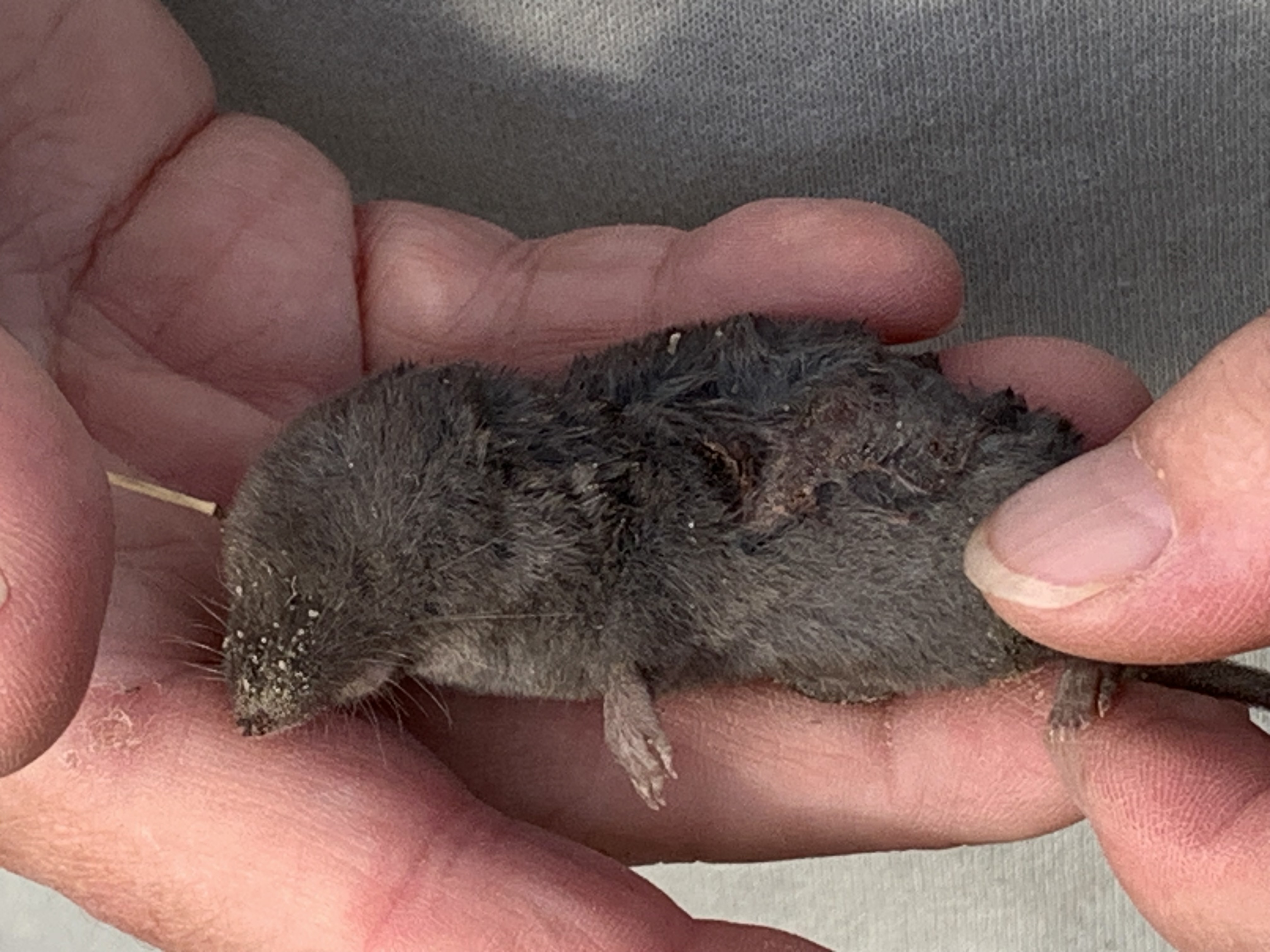There’s nothing better than a personal, physical experience to help me see something new. That’s why, on our walk the other day with both Dave and Clancy, Bryan put a dead, but intact, northern short-tailed shrew (Blarina brevicauda) into the palm of my hand. The soft furry body of the tiny mammal just covered my palm. Its three-quarters of an ounce seemed to be weightless. It had a pointed nose and tiny eyes. Its ears were hidden under that luxurious dark gray fur. The fur is like a mole’s fur—very soft and nondirectional. Its tail was short, thus its name. After a few minutes of inspection, I dropped it on the road, preparing to resume our walk. Instantly, Clancy dove for it and picked it up. Oops! There was no possibility of getting him to drop it, so we just headed up the hill toward home. Clancy carried the furry little bundle carefully in his mouth all the way home. He finally relinquished it, unmarred, at the door.
Handling a dead shrew may have its hazards, but handling a live one is definitely not recommended. Shrews are one of very few mammals with venom glands. When they bite–you or their prey–they inject poison that can kill anything up to their own size, and immobilize larger prey. It won’t kill a human, but it will definitely leave a painful, swollen reminder for days. In addition, their little teeth are like needles, and they have 32 of them. So all in all, getting bitten by a shrew won’t kill you, but you wouldn’t forget it any time soon. The other thing the shrew will do to you is exude a foul-smelling (and foul-tasting) musk from glands on its sides and belly. This discourages you and the coyotes from eating it. In spite of its defenses, northern short-tailed shrews have their share of predators, including owls, foxes, weasels, coyotes and even trout and sunfish if they get too close to water.
The weeds in the ditch along Owl Acres provide plenty of habitat and cover for shrews. They thrive in fields, farmyards, roadside ditches, and gardens where there is cover for them. You almost never see them because they use elaborate tunnel systems beneath the vegetation made by themselves and other small animals to move about their world. They are voracious hunters and eaters of all sorts of insects, snails, and other invertebrates as well as mice and other shrews. They can even capture much larger prey like salamanders by subduing it with their poison. Because of their need to eat up to three times their own weight in food every day, especially in winter, they help keep the insect populations down in their territories.
Shrews have very poor eyesight, perhaps only light perception. They make up for it with their hearing and, like bats, they use echo location to map their environment. They emit a collection of ultrasonic squeaks and clicks which humans can’t year. They don’t use the echo location to hunt, though. They rely instead on their very sensitive noses and whiskers. In the summer, they are active around the clock, but more so at night than during the day, gobbling up insects (including, for example, Japanese beetles) to maintain their high metabolism. Because they tend to stay underneath the foliage, we don’t see them very often. They are solitary most of the year, and the males defend their territories by fighting. Females build nests where they raise half a dozen shrewlets a couple times a year.
In the winter, shrews do not hibernate. They stay active, foraging during the day when it’s warmer, and curling up in their leaf-lined nests under the snow and leaf litter at night when it’s colder. They have a method of warming themselves known as nonshivering thermogenesis to maintain their 101-degree body temperature. They require lots of food to keep such a high metabolism going in such a little creature. If they can’t get enough food, they will freeze to death. In spite of their defenses and the caches of food they stash in their nests in the summer and fall, up to 90% of them don’t survive the winter.
Shrews are not rodents. Instead, they are related to moles. The northern short-tailed shrew is native to North America and lives in Canada and as far south as central Nebraska. It is one of six native shrew species living in the United States. It has relatives in England, though.
Beginning in the 13th century in England, the term “shrew” was used to refer to an ill-tempered or nagging woman. Shakespeare set his “The Taming of the Shrew” around this concept, as did Cole Porter with “Kiss Me Kate.” I’ll leave it to you to decide if the appellation is appropriate.
Clancy will regret it if he ever captures a live shrew. Fortunately, his chances are poor in this regard.
Photo by Author. Alt text: A grey, mouse-size critter with pointy snout, brush-like whiskers and a short tail, rests in Karen’s hands. It’s dead, possibly mauled or road killed. It’s tiny eyes are not visible, buried in the soft fur covering its head. Northern short-tailed shrew.

1 comment
Really GREAT article, fun , well written and thoroughly informative ! Thank you,, Paul Finger